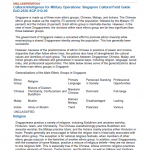Government controls and self-censorship keep the media in prosperous, well-educated Singapore unusually clear of any antigovernment, extremist, or otherwise objectionable material. A government agency runs all broadcast stations, and the ruling party indirectly controls the print media. A variety of restrictions and the threat of libel suits discourage political criticism across all media outlets. This small island republic’s 4.6 million people boast a 92.5% literacy rate, a per capita GDP of nearly USD$50,000 (World Factbook), and a 58.6% Internet access rate (Internet World Stats). There is no prepublication censorship, but media watchdog Reporters Without Borders ranked Singapore 141 out of 169 in its Worldwide Press Freedom Index for 2007, citing “rigorous self-censorship” in coverage of domestic politics. Internet access is regulated, and private ownership of satellite dishes is banned. Singapore government officials also have a record of winning defamation suits against foreign publications (BBC Country Profile, news.bbc.co.uk).
Read more →


